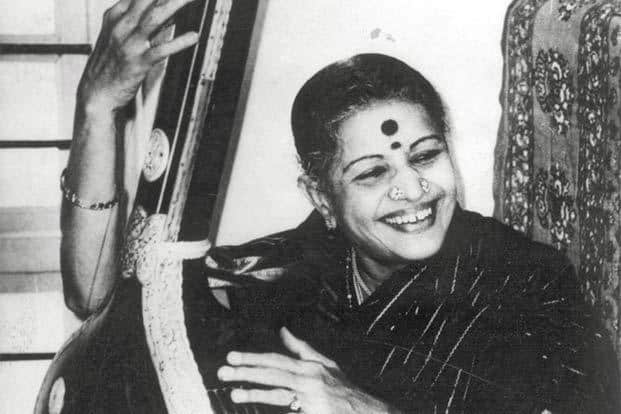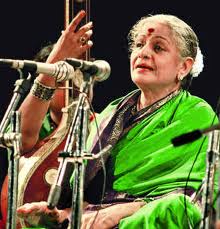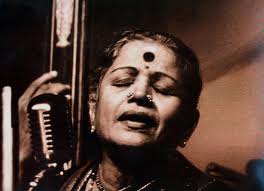Listening to M.S.’s Bhaja Govindam as you read this will improve the sensory experience. That– or Bhavayami Gopala Baalam.
Also, Mint has chosen a photo from their files, but below are my favorite MS photos.
Also, there was a great photo exhibit in Bangalore’s Tasveer Art gallery. It was a foreign photographer…wish I could remember the name. It had a photo of MS standing before Sadasivam relaxing on an easy chair. It conveyed the dynamic of this couple as words cannot. I just loved the photo. God! Wish I could remember the artist.
Lastly, great choice of film by Vidya Balan.
Sat, Feb 23 2013. 12 15 AM IST
Can Vidya Balan do an M.S. Subbulakshmi?
Vidya Balan will play M.S. Subbulakshmi in Rajiv Menon’s biopic of the Carnatic legend

M.S. Subbulakshmi epitomized the Tamil Brahmin aesthetic. Photo: Hindustan Times
So Vidya Balan will play M.S. Subbulakshmi in Rajiv Menon’s biopic of the Carnatic legend? This is exciting news for Chennai’s music lovers. Chennai wakes up to M.S., as she is called. Her rendition of the Suprabhatam and Vishnu Sahasranamam (1,000 names of Vishnu) still remain the versions that are played at south Indian homes and temples in the morning. Her interpretations of classic Carnatic songs such as Thyagaraja’s Pancharatna Kritis (or Five Gems compositions), Annamacharya’s compositions, songs of Mirabai such as Hari Tum Haro, repeated endlessly after Gandhiji’s assassination; and popular Tamil songs such as Yaaro Ivar Yaaro—these are part of Chennai’s collective unconscious.
Then, there was the woman herself. If you grew up in Chennai and were marginally interested in Carnatic music, there was no escaping tales of M.S.
The late Morarji Desai wanted a south Indian woman artist or educator to be inducted into the Rajya Sabha. He asked one of his Tamil-speaking IAS officers to call the musician and make the offer. After some cordial persuasion, M.S. demurred, citing her husband, T. Sadasivam. “He is around me like a kavacham (armour). How can I leave him in Madras and come to Delhi?” she said in Tamil. “I can sing for an audience of a lakh of people but I wouldn’t know what to say to 50 MPs.” Later, she conferred with Kanchi Sankaracharya, her spiritual guru, about the offer. He in turn told her that she ought to do what her heart told her to.
She sang from the heart, this icon. Madurai Shanmukhavadivu Subbulakshmi, a devadasi known—quite wonderfully in this age of feminism—by her mother’s name, became second wife to the strict patriarchal freedom fighter, Sadasivam. She deferred to him entirely. He orchestrated her career and made her a national celebrity whom Jawaharlal Nehru called the “queen of song”.
Her music had the bhakti rasa that touched hearts. It was her voice that soothed millions after Gandhiji’s assassination. India saluted it with a Bharat Ratna, the first ever awarded to a singer. T.J.S George’s biography (MS: A Life in Music) captured much of her turbulent history, but missed many anecdotes from her daily life. For that, you had to be a music lover in Chennai during her time. Sooner or later, you would be drawn into her orbit.
There were some purists who thought that it was the magic of her persona, more than her music, that made her popular and carried her to Carnegie Hall. Critics said that her manodharma or free-form alapana wasn’t as imaginative as M.L. Vasanthakumari’s, her contemporary. Others said that her grip on classicism wasn’t as sure as D.K. Pattammal’s. She knew fewer songs; her Sanskrit pronunciation was good but not perfect. And who was she to be singing the Hanuman Chalisa in a south Indian accent? But these were quibbles that were swept away by her beauty, charisma, the humility she seemed to personify as she sang: the half-closed eyes, face turned upwards, palms together prayerfully. It was a classic M.S pose. Her devotion, however, was real. She lost herself in the music and pulled others into its transcendental depths with her.
In life, she was soft, humble and content. She ate Tamil vegetarian food, donated generously and lived simply, save for her shringara (beauty) and alankara (adornment).
A Carnatic musician and teacher, the late Meera Seshadri, lived in Kotturpuram, just a few streets away from where M.S. lived. She spoke about visiting “M.S. Amma” one day to find the great lady perfuming her hair with “sambrani” incense after an oil bath. The incense burner was on the mosaic floor with a wicker basket over it. Across the basket was M.S.’ luxuriant curly hair, absorbing the twisting smoke and its fragrance in the dim cool room.
For many, M.S. epitomized the Tamil Brahmin aesthetic: straight parting; slightly oiled hair pulled back into a braid or a chignon adorned with Madurai jasmine flowers; bright red bindi; Kanjeevaram silk saris in jewel tones with poetic names borrowed from nature such as peacock blue, onion skin pink, mango yellow, parrot green; star-shaped diamond earrings; the all-important diamond nose rings—a solitaire on one nostril, and a triumvirate on the other; at least two necklaces, including the long, hanging mangalsutra; bangles on both hands—a mixture of tingling glass bangles interspersed with gold ones; a simple plain blouse that matched the sari—none of the mirror-work or designer blouses, the blouse cut close to the neck without a deep back; the sari pallu worn around the neck; anklets; toe rings for sure; a heady fragrance from a combination of jasmine flowers, sandalwood oil moisturizer and herbal hair oil; and lips red from the betel leaf that is chewed after lunch (M.S. wore lipstick too). This sensuous aesthetic—can you imagine, not one of your senses is left unattended?—is what M.S. modelled. It is how Tamil Brahmin women of that era dressed.
Balan will do a killer impersonation, for sure, for she is a gifted actor. But hopefully she will go deeper. She is portraying not just a beloved national figure, she is portraying someone close to the heart of most Tamilians; a person who they possessively call “namma M.S. (our M.S)”.
Shoba Narayan aspires to M.S.’ sensual aesthetic, but for that, she’ll have to give up her trousers and wear only saris.
Also Read | Shoba’s previous Lounge columns






This is one of my favorite articles about M.S.’s style aesthetic.
http://articles.economictimes.indiatimes.com/2004-12-15/news/27373128_1_carnatic-ms-subbulakshmi-sari
Funnily enough, in M.F.Hussain’s painting he he pictured the diva in a maroon sari. Maybe her fondness for that shade of blue is known only to us South Indians.
Love, love, love it, V. Thank you!
“M.S. Subbulakshmi epitomized the Tamil Brahmin aesthetic”
Ironically, M S Subbulakshmi was not a born brahmin…
Yes, I know, Vengat. I think she compensated for that by embracing her TamBrahm husband’s milieu completely. Her Dad was Brahmin though. But my point is more about the loss of the regional aesthetic. You know, you could tell where a woman was from by the way she wore her sari. Not any more.
I write this with all due respect, but courting a married man (at 20), bringing him away from his wife and eventually marrying him is simply the seduction of a devadasi and totally anti-Brahmin. Simply wearing silk sarees and accessories does not make you a Brahmin. One other poster (here) actually wrote a kick-ass comment about this.
Let me address the peanut gallery before it begins. Some will observe that marriage occurred after the death of his first wife. Humbug. There are very spotty accounts of the death of this first wife. (Some say scorpion bite, but this is non-fatal in over 95% of cases, and some say malaria – in 1936? Sounds like a cover up to me.) The point here is the very notion of such a love is non-Brahminic.
Just think about this. MS was a songstress and performer. Her contemporaries Pattammal and MLVasantakumari were Brahminic i.e. traditional but decidedly un-opulent (did not have a color named after them!). But MS was bejewelled with all the “rights and privileges” of the richness of her garb right down to the lipstick. This is not the restraint and self-control of a Brahmin by any measure; to put it bluntly, this is a bahurupia, a devadasi, a pucca performer dressed in the Prada of her day.
The other poster said it best. “Clothing is an expression of identity not a substitute for one.”
Woah! I am going to wait to see what others say before responding.
Vinay,
Isn’t this a bit harsh?
Let’s check your points. Firstly the accounts of their courtship are as “spotty” (your word) as the details around his first wife. You are assuming MS was some sort of young vixen who seduced an older man away from his wife. I am not sure this is fully valid. Various other accounts describe their family reactions and the fact that Sadasivam even consulted with Rajaji about all this. Remember that Sadasivam was a freedom fighter whose beliefs were unstintingly noble. My point is that this may not have been a “seduction” as you say. Maybe it was mutual and maybe there were other factors that neither of us (or nobody else for that matter) really knows. I think it is unfair, therefore, to portray MS as you did.
Secondly there is much more to MS than just her love life. She was a devoted singer as well as a teacher/philanthropist and she has done many charitable works. These aspects – devotion (to music), charity, selflessness, pupillage – are certainly Brahminical. Shoba was describing how MS embraced and epitomized the Brahmin milieu, which is not necessarily a reflection of MS character.
Also remember that MS was more popular than DKP or MLV possibly because she sang all kinds of songs in many languages. “MS blue” as a color moniker is a measure of peoples’ popularity and not her own avarice. (She did not zip around in a convertible or hold lavish parties at her seafront mansion.) IMHO she is more Pavorotti than Prada.
Vinay you’ve actually got a sharp mind and sharp thinking. All I am saying (as with your other posts) is there may be a broader picture that is not quite so acerbic.
PS – the offer of chilled beer still stands :)
In my congenital compulsion to take up for the underdog (can’t believe that Vinay is the underdog here :), I have to stand up in support. I think Vinay “gets” her musicality. I think his point of dissent is that she was not Brahmin and therefore it was sort of disingenuous of her to embrace an aesthetic that wasn’t hers to begin with. Perhaps it would have been more authentic to do a Bala (Saraswati) who stayed true to her roots as “Veena Dhanammal’s daughter).
Can’t believe I am supporting Vinay :))
Shoba: my [folded hands] thanks for your support :)
NS:
I’ll return the compliment first because I also like your balanced and pragmatic point/s of view.
My point was not to disparage MS life. She has obviously made a lot of positive contributions (as you and Ms Naina say).
My point was: the article seems to indicate that she “adopted the Brahmin asthetic” to such an extent that she epitomized it (epitomize = the perfect example of something). This, IMHO, is not the case. One does not (to borrow from Rawal Khan here) epitomize a perfect Muslim just by donning perfect Hijab. This, precisely, was also Rawal Khan’s point.
Also, I don’t think it was disingenuous of her to adopt an asthetic that was not hers by birth. She is clean in this sense because she did not go around calling herself a Brahmin OR calling others non-Brahminic.
For the record I am all for people to develop new tastes and habits and sensibilities. For example an Indian who develops a genuine liking for say French food does not become a “pseudo”. A “pseudo” is the Indian who loves lecturing about French food at the party but, when he returns home, really gets back to his daal-chawal. This guy is a pseudo because his liking of French food is superficial. He is too Indian. That’s cool, he should just not go on waxing eloquent about beurre blanc is all.
Clean =Purity. The purity/pollution context is getting rather obvious in your statements.
I didn’t see these messages until today….
Clean/Purity — well, yes, obvious, but that’s kind of the point Srishti.
Your “casteist” comment … This article is about MS aesthetic and its “brahminism”, not about her father’s or Gangubai Hangal or anyone else.
Whore/virgin dichotomy is indeed old. But I am wondering what is your real point (over and above what NS and others have said)? It seems rather easy these days to drop a few words – sexist/misogynist/whatever – and move along. I have a word too. It is cranberry.
“The point here is the very notion of such a love is non-Brahminic.”
Casteist,much?
Her father was a brahmin as were a significant number of devdasi patrons. Gangubai Hangal’s father was also a Brahmin patron.
Were their relationships ‘brahamnic’ enough for you?
Sorry to add. It was his marriage,not hers. His choice since HE was married. He was an individual with free will. The whole whore/virgin dichotomy that your sexist,colonized mind has co-opted is a bit old and simply misogynist.
Vinay I actually remember your comments from the previous debate on feminism and Hinduism etc.
I think Shoba was basically describing how MS embraced the TamBram asthetic. That doesn’t mean MS was born a Brahmin (fact) or even necessarily aspired to be one. It’s possible she only wanted to sing as a primary purpose and the style is a necessary but secondary requirement towards that purpose.
I also agree with Mr NS i.e. not sure about the details behind her marriage to Sadasiva. But I have one question here. Isn’t it siginifcant that she remained devoted to this man all through her life? Hardly the trait of a home breaker. Everyone has their ups and downs in life. Regardless of her marriage I think MS has made, on balance, an enormous positive contribution to music and to India.
Thanks, Naina
Vermeer, the Dutch master, was famous for his “Girl With a Pearl Earring”. In South India I am convinced he would have been pressed upon to depict “Lady With a Diamond Nose-Stud.”
:)
the photgrapher is derry mooore
Thanks Pallavi.
welcome ms.shobha..
presently i am working on a biography of ms in telugu.i bought the pic from him.
Oh, ok. Good luck!!